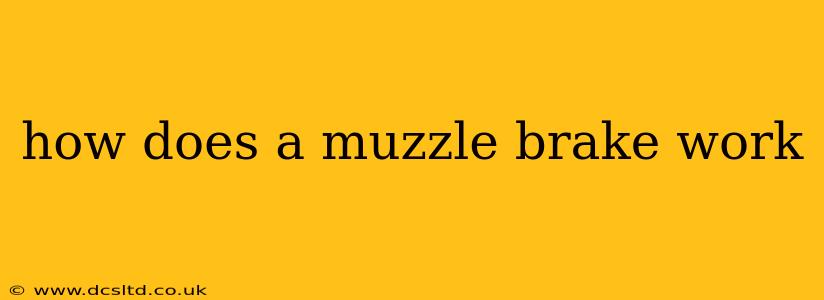Muzzle brakes are popular attachments for firearms, particularly those with significant recoil. But how do they actually work their magic? This detailed explanation will explore the science and engineering behind these effective recoil reduction devices.
At its core, a muzzle brake redirects propellant gases exiting the barrel, counteracting the rearward force of recoil. This isn't a simple process of just venting gases; it's a carefully engineered system designed to manage pressure and momentum.
How Muzzle Brakes Reduce Recoil: The Physics Behind It
The fundamental principle behind a muzzle brake's functionality lies in Newton's Third Law of Motion: for every action, there's an equal and opposite reaction. When a firearm discharges, the expanding propellant gases propel the bullet forward. Simultaneously, the equal and opposite reaction pushes the firearm backward—this is recoil.
A muzzle brake effectively intercepts a portion of these exiting gases and redirects them. This redirection creates a counter-force that opposes the recoil impulse. Different designs achieve this redirection in various ways, leading to different levels of recoil reduction and other effects.
Different Types of Muzzle Brakes and Their Mechanisms
Several designs exist, each with its unique approach to gas redirection:
-
Linear Compensators: These brakes feature ports typically positioned on the top and bottom of the muzzle. Gases are vented upwards and downwards, reducing the vertical recoil component. This is especially beneficial for maintaining target acquisition during rapid firing.
-
Side-Port Brakes: Similar to linear compensators, but the ports are angled to the sides. This is often used to counteract horizontal recoil drift.
-
Radial Brakes: These brakes feature multiple ports radiating outwards from the center. The gases are expelled in all directions, providing a more comprehensive reduction of recoil.
-
Conical Brakes: This is a more advanced design that channels the gases into a conical pattern, effectively managing pressure and creating a directional counter-force to combat recoil.
What are the Pros and Cons of Using a Muzzle Brake?
While muzzle brakes offer significant advantages, they also have drawbacks:
Pros:
- Reduced Recoil: The primary benefit is a noticeable decrease in felt recoil, leading to improved shooter comfort and control, particularly during rapid fire.
- Improved Accuracy: Reduced recoil translates to improved accuracy, especially for longer shots or when using high-caliber firearms.
- Faster Follow-Up Shots: The reduction in recoil allows for quicker target reacquisition and faster follow-up shots, crucial in tactical situations.
Cons:
- Increased Noise and Flash: The redirection of gases can result in a louder report and more visible muzzle flash.
- Potential for Gas to Affect Shooter or Bystanders: Depending on the brake design and firearm platform, directed gases can potentially affect the shooter or those nearby.
- Weight and Size: Muzzle brakes add weight and length to the firearm.
Frequently Asked Questions (PAA)
Q: Do muzzle brakes affect accuracy?
A: Generally, muzzle brakes improve accuracy by reducing recoil and muzzle climb. This leads to better target acquisition and follow-up shots. However, the added weight and length might marginally influence accuracy in some specific situations, but the benefits typically outweigh this.
Q: Are muzzle brakes legal?
A: Muzzle brake legality varies by jurisdiction. Some regions have restrictions or outright bans on certain types of muzzle devices. It's crucial to check local and state laws before attaching one to a firearm.
Q: How much do muzzle brakes reduce recoil?
A: The degree of recoil reduction depends on the muzzle brake design, the firearm caliber, and ammunition used. While exact figures vary greatly, significant recoil reduction is typically experienced.
Q: Can muzzle brakes damage firearms?
A: When properly installed and used with appropriate ammunition, muzzle brakes are unlikely to damage firearms. Improper installation or use could potentially lead to problems, so professional fitting is always recommended.
Q: What's the difference between a muzzle brake and a compensator?
A: The terms are often used interchangeably, but there are subtle distinctions. A compensator primarily aims to reduce muzzle rise, whereas a brake focuses on reducing overall recoil. Many devices perform both functions to some extent.
In conclusion, muzzle brakes are sophisticated devices that effectively reduce recoil by cleverly redirecting propellant gases. While they offer considerable advantages for shooters, understanding their mechanics and potential drawbacks is crucial for making informed decisions. Remember always to check local regulations before using a muzzle brake on your firearm.
